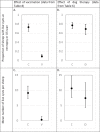Control of cystic echinococcosis in the Middle Atlas, Morocco: Field evaluation of the EG95 vaccine in sheep and cesticide treatment in dogs
- PMID: 33684115
- PMCID: PMC7971873
- DOI: 10.1371/journal.pntd.0009253
Control of cystic echinococcosis in the Middle Atlas, Morocco: Field evaluation of the EG95 vaccine in sheep and cesticide treatment in dogs
Abstract
Background: Cystic echinococcosis (CE) is an important cause of human morbidity and mortality worldwide, particularly in Morocco and other North African countries.
Methodology/principal findings: We investigated the potential of three strategies to reduce Echinococcus granulosus transmission: (1) 4-monthly treatment of dogs with praziquantel, (2) vaccination of sheep with the EG95 vaccine and (3) a combination of both measures. These measures were implemented during four consecutive years in different areas of the Middle Atlas Mountains in Morocco. The outcome of the interventions was assessed through hydatid cyst (viable and non-viable) counts in liver and lungs using necropsy or in vivo ultrasound examination of the liver. A total of 402 lambs were recruited for annual vaccination with the EG95 anti-E. granulosus vaccine and 395 similar lambs were selected as non-vaccinated controls. At approximately four years of age the relative risk (estimated as odds ratio) for vaccinated sheep to have viable hydatid cysts compared with non-vaccinated controls was 3% (9.37% of the vaccinated sheep were found infected while 72.82% of the controls were infected; p = 0.002). The number of viable cysts in vaccinated animals was reduced by approximately 97% (mean counts were 0.28 and 9.18 respectively; p<0.001). An average of 595 owned dogs received 4-monthly treatment during the 44 months trial, corresponding to 91% of the owned dog population. Approximately, 5% of them were examined for E. granulosus adult worms by arecoline purge or eggs in feces (confirmed by PCR). The proportion of infected dogs significantly decreased after treatment (12% versus 35%; p<0.001). Post-treatment incidence of re-infestation corresponded to a monthly risk of 4% (95% CI: 3-6%). Treatment of owned dogs on a 4-monthly basis did not reduce the level of transmission of E. granulosus to sheep, nor did it enhance the level of control generated by vaccination of sheep with EG95, possibly because of unowned dogs and wild canids were not treated.
Conclusions/significance: These data suggest that vaccination of sheep with EG95 has the potential to reduce the level of CE in Morocco and in other parts of the world with similar transmission dynamics. Under the epidemiological circumstances existing in the trial area, 4-monthly treatment of owned dogs with praziquantel was insufficient to have a major impact of E. granulosus transmission to sheep.
Conflict of interest statement
The authors have declared that no competing interests exist.
Figures


References
-
- El Berbri I, Petavy AF, Umhang G, Bouslikhane M, Fassi Fihri O, Boué F, et al.. Epidemiological Investigations on cystic echinococcosis in North-West (Sidi Kacem Province) Morocco: Infection in Ruminants. Adv Epidemiol. 2015: 1–9. 10.1155/2015/104025 - DOI
Publication types
MeSH terms
Substances
LinkOut - more resources
Full Text Sources
Other Literature Sources
Medical

